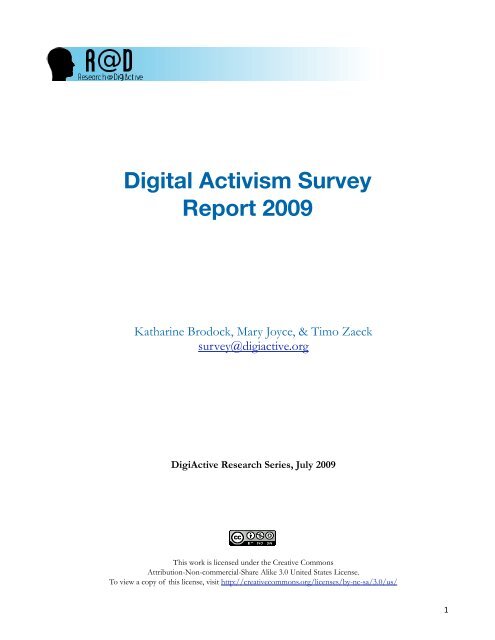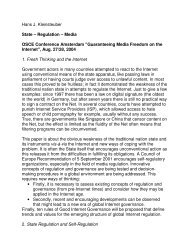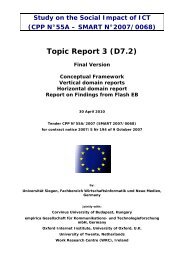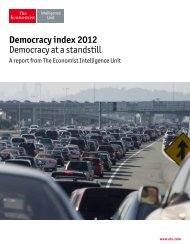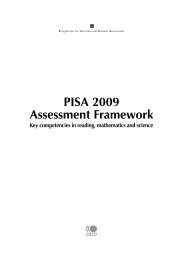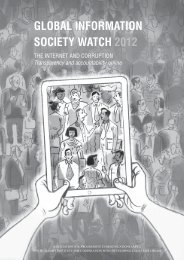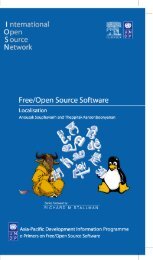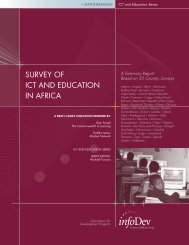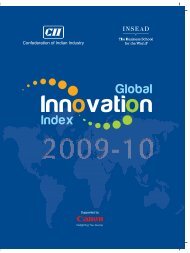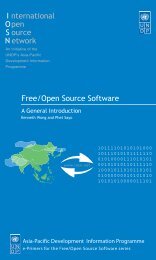Digital Activism Survey Report 2009
Digital Activism Survey Report 2009
Digital Activism Survey Report 2009
Create successful ePaper yourself
Turn your PDF publications into a flip-book with our unique Google optimized e-Paper software.
<strong>Digital</strong> <strong>Activism</strong> <strong>Survey</strong><br />
<strong>Report</strong> <strong>2009</strong><br />
Katharine Brodock, Mary Joyce, & Timo Zaeck<br />
survey@digiactive.org<br />
DigiActive Research Series, July <strong>2009</strong><br />
This work is licensed under the Creative Commons<br />
Attribution-Non-commercial-Share Alike 3.0 United States License.<br />
To view a copy of this license, visit http://creativecommons.org/licenses/by-nc-sa/3.0/us/<br />
!
"""""""""""""""""""""""""""""""""""""""""""""""""""""""""""""""""""""""""""""""""""""""""""""""""""""""""""""""""""""""""""""""""""""""""""""""""" above: respondents’ personal definitions of digital activism<br />
Key Findings<br />
Age: Of the survey’s 122 respondents, 28% were between the ages of 26 and 30, with 10% above age 50<br />
and only 2% below the age of 20. The low activism rates of these young “digital natives” may be<br />
explained by political apathy and entertainment preferences online.<br />
Gender: Outside North America, male respondents outnumbered female respondents by a margin of 7 to<br />
3. If this gap holds true for digital activists in general, this further challenges the gender-neutral identity of<br />
technology.<br />
Geography: Geographic representation was largely consistent with global Internet access but should not<br />
be used as representative of the true distribution of digital activists around the world.<br />
Economics: <strong>Digital</strong> activists, particularly in developing countries, are much more likely than the population<br />
at large to pay a monthly subscription fee to have Internet at home, to be able to afford a high-speed<br />
connection, and to work in a white-collar job where Internet is also available. In short, digital activists are<br />
likely to be prosperous.<br />
Access: Intensity of use, rather than simple access, is critical as to whether or not a person is a digital<br />
activist. This high use is only possible for people with the ability to pay for it. The Internet may be<br />
2
democratizing, but its effects are felt most strongly in the global middle class.<br />
Mobiles: Respondents with more features on their mobile phone - such as Internet, video, and GPS - are<br />
more likely to use their phones for activism. This is another indicator of the importance of financial<br />
resources for digital activists, both quantitatively, in terms of greater technology access, and qualitatively, in<br />
terms of better (mobile) hardware.<br />
Causes: Across regions, “rights” emerged as the most popular cause, with 21 different types identified by<br />
respondents.<br />
Broadcast: The plurality of respondents (37%) believe digital technology’s greatest value for activism is<br />
one-way communication. What makes social media useful for digital activism may not be its interactivity<br />
but rather the fact that these technologies collapse the barrier to broadcast.<br />
Platforms: Social networks are the most common “gateway drug” into digital activism.<br />
Design: None of most popular activist tools – social networks, blogs, and email - were specifically made<br />
for activism. It is likely a combination of their open and agnostic architecture, as well as their high user<br />
base, that has made them popular with activists.<br />
Skills: Findings on technology and advocacy skills acquisition challenge the assumption that those who<br />
have a facility with technology are more likely to become digital activists and gives encouragement to<br />
programs that seek to teach technology skills to traditional activists.<br />
Offline: Older activists in the respondent group are most likely to use digital technology to increase the<br />
efficiency of offline activities, such as training and evidence collection, and less likely to participate in<br />
activities which have gained popularity because of the availability of online tools, such as posting original<br />
content on web sites.<br />
3
TABLE OF CONTENTS<br />
!ntroduction . . . . . . . . . . . . . . . . . . . . . . . . . . . . . . . . . . . . . . . . . . . . . . . . . . . . . . . . . . . . . . . . . . . . . . . . . . . . . . . . . . . . . . . . . . . . . 5<br />
This is a Beta Release . . . . . . . . . . . . . . . . . . . . . . . . . . . . . . . . . . . . . . . . . . . . . . . . . . . . . . . . . . . . . . . . . . . . . . . . . . . . . . . 5<br />
Methodology and its Discontents . . . . . . . . . . . . . . . . . . . . . . . . . . . . . . . . . . . . . . . . . . . . . . . . . . . . . . . . . . . . . . . . . . . . . 5<br />
Demographics . . . . . . . . . . . . . . . . . . . . . . . . . . . . . . . . . . . . . . . . . . . . . . . . . . . . . . . . . . . . . . . . . . . . . . . . . . . . . . . . . . . . . . . . . . . 6<br />
Late Twenty-Somethings Lead Teens in <strong>Activism</strong> . . . . . . . . . . . . . . . . . . . . . . . . . . . . . . . . . . . . . . . . . . . . . . . . . . . . . . . . 6<br />
Gender Imbalances Hinge on Geography . . . . . . . . . . . . . . . . . . . . . . . . . . . . . . . . . . . . . . . . . . . . . . . . . . . . . . . . . . . . . . .8<br />
Geographic Representation Consistent with Access but Perhaps not Representative . . . . . . . . . . . . . . . . . . . . . . . . . . . . 9<br />
Technology Use. . . . . . . . . . . . . . . . . . . . . . . . . . . . . . . . . . . . . . . . . . . . . . . . . . . . . . . . . . . . . . . . . . . . . . . . . . . . . . . . . . . . . . . . .12<br />
Internet . . . . . . . . . . . . . . . . . . . . . . . . . . . . . . . . . . . . . . . . . . . . . . . . . . . . . . . . . . . . . . . . . . . . . . . . . . . . . . . . . . . . . . . . 12<br />
Heavy Internet Use is Crucial Factor . . . . . . . . . . . . . . . . . . . . . . . . . . . . . . . . . . . . . . . . . . . . . . . . . . . . . . . . . . . . . . . . . 12<br />
A Variety of Access Points but Home Leads . . . . . . . . . . . . . . . . . . . . . . . . . . . . . . . . . . . . . . . . . . . . . . . . . . . . . . . . . . . 13<br />
Faster Internet Speeds are Prevalent . . . . . . . . . . . . . . . . . . . . . . . . . . . . . . . . . . . . . . . . . . . . . . . . . . . . . . . . . . . . . . . . . . 13<br />
<strong>Digital</strong> <strong>Activism</strong> as an Activity of the Global Elite . . . . . . . . . . . . . . . . . . . . . . . . . . . . . . . . . . . . . . . . . . . . . . . . . . . . . . 14<br />
Mobile . . . . . . . . . . . . . . . . . . . . . . . . . . . . . . . . . . . . . . . . . . . . . . . . . . . . . . . . . . . . . . . . . . . . . . . . . . . . . . . . . . . . . . . . . 15<br />
Half Use Mobile for Advocacy, Regardless of Region . . . . . . . . . . . . . . . . . . . . . . . . . . . . . . . . . . . . . . . . . . . . . . . . . . . .15<br />
Mobiles Used for Content Generation Rather than Organizing . . . . . . . . . . . . . . . . . . . . . . . . . . . . . . . . . . . . . . . . . . . . 15<br />
Many Respondents Have Fancy Phones, Mobile Web . . . . . . . . . . . . . . . . . . . . . . . . . . . . . . . . . . . . . . . . . . . . . . . . . . . . 16<br />
Platforms and Apps . . . . . . . . . . . . . . . . . . . . . . . . . . . . . . . . . . . . . . . . . . . . . . . . . . . . . . . . . . . . . . . . . . . . . . . . . . . . . .17<br />
Activists More Likely to Broadcast than Interact . . . . . . . . . . . . . . . . . . . . . . . . . . . . . . . . . . . . . . . . . . . . . . . . . . . . . . . . 17<br />
Social Networks as the “Gateway Drug” of <strong>Digital</strong> <strong>Activism</strong> . . . . . . . . . . . . . . . . . . . . . . . . . . . . . . . . . . . . . . . . . . . . . .19<br />
Older Social Media Plays a Leading Role . . . . . . . . . . . . . . . . . . . . . . . . . . . . . . . . . . . . . . . . . . . . . . . . . . . . . . . . . . . . . . 19<br />
Does the Hype Cycle Mislead Activists . . . . . . . . . . . . . . . . . . . . . . . . . . . . . . . . . . . . . . . . . . . . . . . . . . . . . . . . . . . . . . .20<br />
Causes . . . . . . . . . . . . . . . . . . . . . . . . . . . . . . . . . . . . . . . . . . . . . . . . . . . . . . . . . . . . . . . . . . . . . . . . . . . . . . . . . . . . . . . . . . . . . . . . . 22<br />
Many Causes Differ by Regional Context . . . . . . . . . . . . . . . . . . . . . . . . . . . . . . . . . . . . . . . . . . . . . . . . . . . . . . . . . . . . . 22<br />
… But Rights Leads Worldwide . . . . . . . . . . . . . . . . . . . . . . . . . . . . . . . . . . . . . . . . . . . . . . . . . . . . . . . . . . . . . . . . . . . . . .23<br />
Tech Causes Surprisingly Limited . . . . . . . . . . . . . . . . . . . . . . . . . . . . . . . . . . . . . . . . . . . . . . . . . . . . . . . . . . . . . . . . . . . . 24<br />
Work and Skills . . . . . . . . . . . . . . . . . . . . . . . . . . . . . . . . . . . . . . . . . . . . . . . . . . . . . . . . . . . . . . . . . . . . . . . . . . . . . . . . . . . . . . . . .25<br />
For Half of Respondents, <strong>Activism</strong> is both Work and Play . . . . . . . . . . . . . . . . . . . . . . . . . . . . . . . . . . . . . . . . . . . . . . . 25<br />
Traditional Advocates and Techies Equally Likely to Become <strong>Digital</strong> Activists . . . . . . . . . . . . . . . . . . . . . . . . . . . . . . . 25<br />
Boomer Activists use <strong>Digital</strong> Tools to Improve Offline Tactics . . . . . . . . . . . . . . . . . . . . . . . . . . . . . . . . . . . . . . . . . . . . 26<br />
<strong>Digital</strong> Activists in Their Own Words . . . . . . . . . . . . . . . . . . . . . . . . . . . . . . . . . . . . . . . . . . . . . . . . . . . . . . . . . . . . . . . . . . . . . . 27<br />
Success Stories: Traditional Institutions Incorporate New Technologies . . . . . . . . . . . . . . . . . . . . . . . . . . . . . . . . . . . . . 27<br />
Success Stories: New Tools Provide Critical Support in Crisis . . . . . . . . . . . . . . . . . . . . . . . . . . . . . . . . . . . . . . . . . . . . . 28<br />
Failure Stories: Study of Challenges Lacks Clear Trends . . . . . . . . . . . . . . . . . . . . . . . . . . . . . . . . . . . . . . . . . . . . . . . . . .28<br />
Most are <strong>Digital</strong> Activists, But Some are Activists Who Just Happen to be <strong>Digital</strong> 21<br />
About the<br />
Authors . . . . . . . . . . . . . . . . . . . . . . . . . . . . . . . . . . . . . . . . . . . . . . . . . . . . . . . . . . . . . . . . . . . . . . . . . . . . . . . . . . . . . . . . . . . . . . . . 31<br />
Appendix: The <strong>2009</strong> <strong>Digital</strong> <strong>Activism</strong> <strong>Survey</strong> . . . . . . . . . . . . . . . . . . . . . . . . . . . . . . . . . . . . . . . . . . . . . . . . . . . . . . . . . . . . . . . .33<br />
4
INTRODUCTION<br />
This is a beta release<br />
This report is a photograph taken from the window of a speeding car. It is a “beta” release. Despite the<br />
challenges of researching the world's digital activists we felt a need to record - in some rough way - this<br />
evolving demographic. We hope that this report will be a challenge to researchers, scholars, academic<br />
institutions, activists, and NGOs to produce deeper and more robust research on this fascinating group.<br />
Our original data set is available for download on the DigiActive site and we welcome comments and<br />
critique at survey@digiactive.org.<br />
Our goal in creating this survey was to collect the first international demographic data on the new group<br />
we call "digital activists": people who use digital technology as part of grassroots campaigns for social and<br />
political change. From late mid-February to mid-April of <strong>2009</strong>, DigiActive collected 122 responses<br />
through an open online form, followed by three rounds of qualitative and quantitative analysis by<br />
Katharine Brodock and Mary Joyce of DigiActive and Timo Zaeck of the University of Siegen. In future<br />
iterations of this survey we hope to partner with a wider array of partners to improve the diversity and<br />
quality of our sample and our research.<br />
Methodology and its discontents<br />
How do you create a sample for a population whose numbers and characteristics are unknown This was<br />
but one of the challenges in creating the <strong>2009</strong> <strong>Digital</strong> <strong>Activism</strong> <strong>Survey</strong>. Thirty-eight percent of our<br />
respondents are from the United States. While one interpretation is that a preponderance of digital<br />
activists live in the US, we likely oversampled this group. While our principal means of soliciting<br />
responses was through the DigiActive web site, Facebook group, and email list, we attempted to increase<br />
the geographic variation of the sample by promoting the survey on the listserv of an international<br />
infoactivism training group for individual activists and NGO workers organized by Tactical Technology<br />
Collective. The group included large contingents from Africa and South Asia. Perhaps we oversampled<br />
this geographic group. More likely we undersampled them. We also acknowledge confirmation bias. The<br />
survey was called the <strong>Digital</strong> <strong>Activism</strong> <strong>Survey</strong> and thus attracted people who self-identify in that way.<br />
Since we do not propose that this survey is a representative sample of the world's digital activists, in what<br />
frame of mind should the reader view this report With an open mind and a grain of salt. All the<br />
findings in this report are consistent with previous research or supported by the anecdotal information<br />
about digital activists that has led research in the field up to this point. If we did not think that a finding<br />
might be true of the digital activist population at large we did not record it here. However, in all cases<br />
more research is needed to confirm or disprove the validity of these findings in the population and we<br />
take care to state this whenever possible.<br />
We would like to thank Johanna Niesyto and Veronika Kneip of the University of Siegen, Chris Kennedy<br />
of Rock the Vote, Corinna di Gennaro of the Berkman Center for Internet and Society, Dan MacQuillan<br />
of Internet Artizans, and Patrick Meier of DigiActive for their help in advising us in this project. Any<br />
omissions or errors are entirely our own.<br />
Many Thanks,<br />
Kate, Mary, and Timo,<br />
5
DEMOGRAPHICS<br />
Late Twenty-Somethings Lead Teens in <strong>Activism</strong><br />
To better analyze the ages of our group of 122 respondents, we broke them into five-year ranges,<br />
beginning with 11 to 15 and ending with 61 to 65 (see graph below). Among respondents, 26 to 30-yearolds<br />
(purple bar) were by far the largest group, making up 28% of the total . 1 However, many other age<br />
groups were well represented. The second-largest group, the 31 to 35-year-olds, made up 16% of the total,<br />
and the other groups from age 21 to 50 contributed about 10% each. Not surprisingly, after age 50<br />
responses decrease, with only 10 respondents in the 51 to 65 range. However, the real surprise is in the<br />
lack of young people among the ranks of digital activists. There were only two responses within the age<br />
range 11 to 20.<br />
Figure 1: Age of Respondents<br />
Does this mean that there are really more digital activists over 50 than under 15 Our sample isn't large<br />
enough to say. However, the absence of young users in the activism space is inconsistent with other data<br />
on youth internet use. Research by the Pew Internet and American Life Project, which provides the most<br />
thorough (though geographically-limited) information on generational Internet use, confirms the suspicion<br />
!<br />
"#$%&$'()*$+")%$"%,-'.$."(,"/0,1$"'-23$%+4<br />
6
that teenagers go online in greater numbers than older users. In their report "Generations Online in <strong>2009</strong>,"<br />
they note that 93% of Americans 12 to 17 are online, more than any other age group. <strong>Digital</strong> activism was<br />
not among the activities studied by the Pew researchers, but the key to why this group isn't active politically<br />
is revealed in what that young group is doing online. According to the Pew generational report, nearly 80%<br />
of users 12 to 17 are going online to play games. However, they are also likely to be members of online<br />
social networks, a key "gateway drug" to digital activism.<br />
If the lack of digital activism of Internet-savvy “digital natives” is a broader trend, what might its causes<br />
be A response on a Yahoo! Answers forum on teens and political apathy gives the classic response: "Most<br />
teens are too interested in the latest Abercrombie releases, Wii games, and Brittany [sic]. You're going to<br />
have to change the whole make-up of teens to make much difference." This hypothesis assumes that the<br />
basic problem is the political apathy of young people and that the Internet, even if it makes political action<br />
more accessible, is not going to change that. In an email Corinna di Gennaro, a fellow at the Berkman<br />
Center for Internet and Society and a researcher on the book “<strong>Digital</strong> Natives” corroborates the apathy<br />
theory: “we found the same from our… focus groups - the younger kids were very much politically<br />
disengaged - but very creative and active online - college age kids on the other hand and some high<br />
schoolers were much more civically aware and engaged, both online and offline.”<br />
So what are the magic ingredients that make 26 to 30-year-olds digital activists These respondents are<br />
beyond their student days when youthful idealism, new political ideas absorbed on campus, and a lack of<br />
familial responsibility and professional preoccupation combine to make young people on universities the<br />
world over into political activists. The 26 to 30 group is out of school and into their first years of<br />
adulthood. They are in a sweet spot of technical expertise and political idealism, not as technologically<br />
immersed as the digital natives, but just slightly removed from that level of engagement. Yet, unlike the<br />
digital natives, who may be more concerned with gaming and pop music than human rights, the 26 to 30<br />
cohort have been around long enough to mix the idealism of youth with the experience and education of<br />
adulthood.<br />
However, it is also important to note that this divide in activism among respondents is not necessarily<br />
caused by the digital medium, but may simply be an online expression of pre-existing offline trends.<br />
According to Veronika Kneip of the Changing Protest and Media Cultures project at the University of<br />
Siegen, it would be necessary to compare this data to studies of political activism before digitalization to<br />
know for certain. “Has there ever been significant political activism of people younger than 20“ she asks.<br />
“Hasn’t the 26-30 group always been the key force” However, Ms. Kneip is also optimistic about the<br />
political effects of the digital environment on digital natives. “Young people cannot necessarily be<br />
7
characterized by a special political apathy – the digital natives may develop new and special ways of digital<br />
activism when they have reached the key force age.” We look forward to seeing future research on this<br />
topic that will demonstrate through more rigorous sampling the effect of digital technology on propensity<br />
for activism.<br />
Gender Imbalances Hinge on Geography<br />
Of the 121 respondents who gave their gender on the survey, 48 identify as female while 73 identify as<br />
male, a 2:3 gender split in favor of men. Yet this global figure masks extreme regional variation. Of North<br />
American respondents from the US and Canada, 28 are female and 27 are male - a near 1:1 split. In this<br />
case, parity in digital activism mirrors parity in Internet access: according to Pew's 2005 "How Women and<br />
Men Use the Internet" report, the US has near parity in Internet use between men and women.<br />
Figure 2: The Gender Gaps<br />
All Respondents North America Outside North America<br />
(40% - 60%) (50% - 50%) (30% - 70%)<br />
Outside of North America, the global gender balance was more skewed, with the divide breaking down to<br />
20 female and 45 male, a 3:7 split in favor of men. Thus the parity in North America actually masks a<br />
more drastic global imbalance. Does this gender imbalance in digital activism match Internet access rates<br />
for men and women, as was the case in North America The sample is too small to say, unfortunately.<br />
One important note is that the balance in Internet access does not appear to universally mirror Internet<br />
8
penetration. For example, in wealthy and wired Western Europe, only 3 respondents were women and 13<br />
were male. This lack of correlation between Internet access and gender access is supported by previous<br />
research. According to the 2005 report "<strong>Digital</strong> Divide to <strong>Digital</strong> Opportunity: Measuring the Information<br />
Society" by George Sciadis, even though Internet penetration is closely linked to GDP, it is not an<br />
indicator of the gender divide in Internet access, particularly in countries with low overall access. For<br />
example, while there was approximately 7% Internet penetration in South Africa in 2005, 48% of those<br />
users were women. In Bulgaria, however, where there penetration was roughly the same, only 10% of<br />
women had access.<br />
ICT for development pioneer Nancy Hafkin surmises that these gender inequalities hinge on cultural<br />
practices deeper than technology access. At a talk at the Berkman Center for Internet and Society in 2006<br />
she noted that "access to technology isn’t gender neutral - there’s a complex set of factors that make it less<br />
likely that women will get access to technology." For example "In most developing nations, access to the<br />
Internet is from public centers, not from the home.... Because of the poor reputation of cyber cafes,<br />
parents discourage girls from going....." In a school case in Uganda documented by the women's<br />
technology group WOUGNET, "seats in a computer lab were given to the students who arrived first. The<br />
boys ran from the classroom to get seats, but the girls - who’d been trained to be polite and ladylike -<br />
walked and didn’t get a single seat." (Quotes are paraphrased from Berkman Fellow Ethan Zuckerman's<br />
blog.)<br />
Does gender inequality in digital activism mirror the same cultural factors as technology access in general,<br />
or is it a result of other social dynamics Are women under more pressure to avoid political persecution<br />
Are they discouraged from taking on the public roles often associated with digital activism Are they less<br />
comfortable with the technology We look forward to seeing more research on the link between gender<br />
and online political participation around the world both to verify the gender gap in digital activism and to<br />
explain it.<br />
Geographic Representation Consistent with Access but Perhaps not Representative<br />
Geographically, North America represented 47% of survey respondents, while Asia as a whole accounted<br />
for 20% and Western Europe accounted for 13%. 2 These statistics fall in line with the Internet World<br />
Statistics reports. In addition to North America, Asia and Western Europe are both highly connected<br />
regions. The low levels of representation from Central and Eastern Europe and Central Asia and the<br />
5<br />
"611",7",-%"%$*8,')1")++8*'2$'(+"7,11,/"(0$".$+8*')9,'+",7"(0$"8'($%')9,')1"&89:$'"2$.8)"+8($";1,3)1"
Caucasus (both less than 1%) were in line with the percentage of world users that are currently accessing<br />
the internet in those regions.<br />
However, it is important to note that the geographic distribution of respondents should not be used as a<br />
proxy for the distribution of digital activists around the world. For example, 38% of the 120 respondents<br />
who identified their country of origin reported that they were from the United States. This data matches<br />
the visitor statistics to the DigiActive website, which indicates that perhaps this does not represent a true<br />
distribution of digital activists around the world, especially when compared to Internet usage statistics<br />
gathered in the survey itself, which showed little to no difference between country/region and internet<br />
usage. This is most likely a result of DigiActive's dissemination process: the survey was heavily promoted<br />
on the DigiActive website, and the visitor statistics to the site closely match the responses in the survey.<br />
Also, while the percentage of world users in South and Central America was almost 11% in 2008 at a<br />
penetration rate of 30%, survey respondents from the area only accounted for 2.5%. This is likely because<br />
DigiActive does not produce content in Spanish or Portuguese and thus has few site visitors from that<br />
region.<br />
Figure 3: Geographic Distribution of <strong>Survey</strong> Respondents<br />
10
Though geographic data should be taken with a grain of salt, there are some interesting outlier cases<br />
whose validity is supported by other trends. One interesting case is India, from which close to 11%<br />
responded, a significantly higher response rate than many other countries. Is this a straightforward result<br />
of the sheer size of its population At a penetration rate of 7% in November of 2008, according to<br />
Internet World Statistics, this conclusion seems possible. In addition, digital activism has a rising profile in<br />
that country. In the prominent recent case of the Pink Chaddis campaign, a blog and Facebook group<br />
were used to organize opposition to a far-right anti-feminist organization in a public shaming where pink<br />
panties (chaddis) were sent to the organization’s members. In addition, social media and blogs were<br />
prominent in the recent national elections.<br />
Overall, there were not any significant and conclusive trends that came out of the country or regional<br />
breakdown in terms of how it may affect digital activism around the world. Several of the following<br />
sections will address variations that hold some correlation to country or regional differences.<br />
11
TECHNOLOGY USE<br />
INTERNET<br />
Heavy Internet Use is Crucial Factor<br />
When asked how often they accessed the Internet, 98% of respondents replied that they went online<br />
multiple times a day. Only two respondents went online less frequently. This finding on the overwhelming<br />
prevalence of heavy Internet use among digital activists was the most consistent and dramatic finding of<br />
the survey.<br />
Figure 4: Frequency of Internet Use<br />
This finding challenges the latent supposition that the growth of cyber cafes and other public access<br />
points in the developing world will lead to an increase in digital activism. A <strong>2009</strong> paper, "Literature Review<br />
on the Impact of Public Access to Information and Communication Technologies" by Araba Sey and<br />
Michelle Fellows, notes that "a small number of studies have concluded that public access to ICTs has<br />
facilitated civic activity," including engaging users in local and national politics and serving as a physical<br />
location for civic activities. However, our findings indicate that intensity of use is more important than<br />
simple access. This is also consistent with the recent research of Eszter Hargittai of Northwestern<br />
12
University, whose Web Use Project focuses on the difference in skills and usage patterns of those with<br />
Internet access, and of Microsoft’s Danah Boyd, whose research on social networks shows that social and<br />
economic differences are often replicated online, instead of being mitigated by access.<br />
A Variety of Access Points but Home Leads<br />
According to our survey, home Internet access is the key to heavy use. Ninety-two percent of respondents<br />
have Internet access in their homes. (Access to mobile Internet will be discussed in a subsequent section.)<br />
The correlation between heavy Internet use and the presence of a home Internet connection is nearly one<br />
to one. This is not to say that cyber cafes and other public access points play no role in digital activism,<br />
only that they are not the crucial factor.<br />
In fact, respondents do access the Internet from multiple locations, including public ones. Respondents<br />
were most likely to use the Internet at home (90%) or at work (89%), while 40% accessed the Internet at a<br />
cyber cafe and 46% found access at a school, library, or other free access point. However, it is important to<br />
note that for the vast majority of respondents, regardless of country, cyber cafes and free access points<br />
were not their primary means of accessing the Internet.<br />
Faster Internet Speeds are Prevalent<br />
The speed of the connection was also salient, though less important than intensity of use and home<br />
access. Of respondents, only 9% identified their connection as slow or very slow (less than 56 kb/sec to<br />
256 kb/sec) while 67% identified their connection is fast or very fast (1 mb/sec to more than 8 mb/sec),<br />
with the rest having a moderate connection. As expected, there was a high correlation between<br />
respondents who did not have home Internet access and those who had slower Internet speeds. However,<br />
it is important to note that those without home Internet were not using the Internet from a cyber cafe, but<br />
rather from the work place, indicating that these respondents have white-collar office jobs where Internet<br />
access is provided to employees. This finding has significant implications as to the socio-economic profile<br />
of digital activists.<br />
13
<strong>Digital</strong> <strong>Activism</strong> as an Activity of the Global Elite<br />
What conclusions can we draw from these figures on Internet access As mentioned at the end of the<br />
previous section, taken cumulatively this data draws a clear picture of the economic situation of the<br />
respondents. The survey did not request respondents to state their income because salary levels and<br />
purchasing power differ greatly from country to country. However, the data we do have draws a clear<br />
picture of a global prosperous class.<br />
Regardless of country or region, the respondents to this survey are very likely to have a high-speed home<br />
Internet connection. This statistic means little in the context of the United States where approximately<br />
63% of American homes have a broadband Internet connection. However, outside North America and<br />
Europe, home access is more unusual. For example, of the 13 Indian respondents to the survey, 77% have<br />
a home Internet connection and the remainder access the Internet from work, while India's overall<br />
Internet penetration is only 7%. Access rates for digital activists from countries in the Middle East, Sub-<br />
Saharan Africa, and Southeast Asia were likewise much higher than penetration rates for the majority of<br />
the population of those areas. This information leads us to believe that digital activists, particularly in<br />
developing countries, are much more likely than the population at large to pay a monthly subscription fee<br />
to have Internet at home, to be able to afford a high-speed connection, and to work in a white-collar job<br />
where Internet is also available. In short, digital activists are likely to be prosperous. Further research will<br />
be needed to verify this hypothesis outside the respondent sample.<br />
What does it mean if digital activists are part of the socio-economic elite It implies a corollary to the<br />
political empowerment thesis of the Internet. Yes, the Internet does empower people who previously did<br />
not have the means of mass broadcast, collaboration, and collective action. Yes, the Internet does to some<br />
extent decouple money and power by decoupling money and mass communication... but only up to a<br />
point. Merely having Internet access does not appear to be sufficient to turn a user into a digital activist.<br />
Rather, intensity of use is key and this intensity of use is only accessible to people with the ability to pay<br />
for it. The Internet may be democratizing, but its effects are felt most strongly in the global middle class.<br />
In addition to sharing common patterns of economic status and technology use, respondents to the<br />
survey were also likely to work toward similar goals. For example, 47% of respondents are working for<br />
rights-based issues. This global activist group may represent a new international class with international<br />
values which are not determined by national political systems but by universal values.<br />
14
MOBILE<br />
Half Use Mobile for Advocacy Regardless of Region<br />
In addition to asking respondents about Internet usage, we also investigated their mobile use. There was a<br />
fairly even division between those who used their mobile for advocacy (48%) and those who did not<br />
(51%). (Two people gave no answer.) This even split carries through from region to region. In regions<br />
with higher access to the Internet, such as North America or Western Europe, about the half the people<br />
are using their mobile for advocacy. Likewise, mobile use is split evenly in regions with lower access to the<br />
Internet, such as the Middle East, Sub-Saharan Africa, and South and Central America, though there is less<br />
data on these areas. As mobile phone use is certainly more prevalent than the Internet in these latter<br />
regions and mobile access nears (and sometimes exceeds) 100% in North America and Western Europe,<br />
equal usage of mobile for advocacy is surprising. These findings may simply be the result of a nonrepresentative<br />
sample, or perhaps awareness of the value of mobile for activism is higher in the North<br />
than in the South. If it is indeed unequal awareness that leads to unequal use, this trend is likely to change<br />
given the rising global awareness of SMS services like Twitter as tools for activism through prominent<br />
cases in Moldova and Iran.<br />
Mobiles Used for Content Generation Rather than Organizing<br />
Besides usage, there is the question of how people use their mobile for activism. In general, people prefer<br />
to use their mobile to collect and disseminate content rather than for collective action. In the range of<br />
usage possibilities, SMS and Twitter are on top with 15% of respondents in each case. Beside this, taking<br />
photos and video follow with 11% and 9%, part of the more general activity of disseminating<br />
information. In a 2008 paper entitled “A Mobile Voice: The Use of Mobile Phones in Citizen Media,”<br />
Katrin Verclas of MobileActive.org notes that “mobile phones are changing the way people consume and<br />
produce media throughout the world. They have become the most widely used form of information<br />
communication technology in human history.” Yet more complex activities beyond content creation (many<br />
of which require a data connection), such as email, organizing, web browsing, and campaigning, are less<br />
common.<br />
15
Figure 5: The 4 C’s of Social Media<br />
This preference for content generation over collective action is consistent with the 4 C’s of Social Media<br />
(see figure left), a theory developed by Gaurav Mishra, CEO and co-founder of the social media analytics<br />
firm 20:20 Web Tech. According to this framework, the use of social media for activism trends towards<br />
increasingly complexity of interaction and cooperation, beginning with simple content generation and<br />
ending with the reputation systems of collective intelligence.<br />
Respondents Have Fancy Phones, Mobile Web<br />
These usage patterns can also be explained through device attributes. The most commonly reported<br />
mobile application was SMS with 87%, followed by 81% with a camera. A large percentage of<br />
respondents do have access to data services, regardless of region, which is consistent with the previous<br />
conclusion that respondents are part of a global elite. Of respondents, 59% are able to send email and<br />
browse the web from their phone. Also, an impressive 35% have GPS.<br />
16
Figure 6 : What Features Does Your Mobile Phone Have<br />
When considering the value of device attributes for activism, it is not only the type but also the number of<br />
features that count. If a respondent’s phone had one to three features they are less likely to use their<br />
phone for advocacy, with only 25% engaged in mobile activism. However, if we take a look at people who<br />
have four or more features we get a different result. In this second case, 62% use their mobile phone for<br />
activism. The salience of features on a mobile phone is a further indication that the likelihood of engaging<br />
in digital activism is closely connected to the financial resources of the individual for reasons of both<br />
quantity and quality: financial resources allow both for increased access and better technology.<br />
PLATFORMS AND APPS<br />
Activists More Likely to Broadcast than Interact<br />
Beyond the level of connection technology, we were also interested in the platforms and applications<br />
(apps) that activists use, and one goal of the survey was to determine the motivation for starting to use<br />
digital tools for activism. While the most frequently cited reason was because of the ability to reach people<br />
(27%), the combined responses that focused on familiarity with the technology (15%), ease-of-use (7%),<br />
and more accessible platform (2.5%) was significantly high at 25%, while the responses for higher<br />
efficiency (12%) and higher effectiveness (13%) - at 25% total - were also indicative of the beneficial<br />
functional aspects that respondents recognized in these tools.<br />
17
These perceived values of digital technology for activism - ease, efficiency, and effectiveness - are not<br />
significantly different from positive perceptions of technology in general. The value that most relates to<br />
digital activism is the perceived importance of reaching people, which reflects an implicit understanding of<br />
the necessity of mass communication to achieve collective action.<br />
As mentioned above, 27% of respondents indicated that the ability to reach people was the reason they<br />
initially used digital tools. This classification was given to respondents who indicated a desire to connect<br />
with people one-to-one, where the respondent was pushing information out but not necessarily receiving<br />
information back. The ability of the tools to then facilitate the broader, one-to-many dissemination of<br />
information was noted as important by 10% of respondents. We could combine these two classifications<br />
to highlight the benefits of digital tools in one-way communications, which would represent 37%.<br />
Far fewer respondents value two-way communication, with 9% identifying communication and<br />
collaboration on a continual basis as being very important, while the opportunities for community building<br />
were important to only 5%. The interactive group represents 14% of respondents, a far smaller number<br />
than the broadcasters’ 37%.<br />
Since the value of social media is often seen as its interactivity, the fact that respondents are more<br />
interested in one-way broadcast is initially surprising. Yet recent prominent examples of the successful use<br />
of social media for mass mobilization and message dissemination, such as Barack Obama’s presidential<br />
campaign and the Twitter broadcasters of Moldova and Iran, support the idea that the value of social<br />
media for any kind of mass mobilization is in broadcast, not conversation. What makes social media<br />
useful for digital activism may not be its interactivity but rather the fact that these technologies collapse the<br />
barrier to broadcast.<br />
A subsequent question as to how activists were using technologies also revealed the prominence of<br />
broadcast over interactive communication. The four most common responses from a list of tool uses<br />
were to “send news to supporters” with 84%, “post information in a static location” with 82%, “create<br />
groups” with 78%, and “mobilize supporters” with 70%, with subsequent using dipping below 40% .<br />
While sending information, posting and mobilizing are broadcast activities, the meaning of the fourth use,<br />
“create groups,” is less clear. While groups certainly can be social and exhibit multi-directional<br />
communication among members, they often are used for broadcast, as in the case of advocacy<br />
organizations’ email lists and Facebook groups in which the group owner messages members but members<br />
do not message each other. In addition, while mobilization is a collective action, the act of mobilizing is<br />
18
centralized as the action is determined at the center and then pushed out to participants through the<br />
network. Given the divided functionality of group creation and the centralized broadcast nature of news,<br />
posting, and mobilization, the responses to this question are consistent with a broadcast theory of social<br />
media for social change.<br />
Social Networks as the “Gateway Drug” of <strong>Digital</strong> <strong>Activism</strong><br />
What was the first tool you used for digital activism According to responses, by far the most common<br />
first tool is the online social network, with 68% of respondents saying this was the first tool they started<br />
using in their activism or advocacy work. Eighteen percent of those specifically mentioned Facebook.<br />
Blogging accounted for 24% of first-time tools, general Internet accounted for 12%, email for 9% and<br />
Twitter for 8%. Email lists and newsgroups were identified as the first tool by nearly 15% of respondents.<br />
Surprisingly, SMS usage at 6% accounted for lower first-time usage than may have been expected.<br />
The prominence of social networks as the “gateway drug” of digital activism is noteworthy, as it was by far<br />
the most common first tool of activists. The low barrier to entry of an activist group on a site like<br />
Facebook has been both praised because it is so easy to become nominally engaged in a cause and<br />
maligned because most users who click through into an activist Facebook group rarely take any further<br />
action. However, at least among the respondents to this survey, the low barrier to entry seems to be a net<br />
positive. Though most members of Facebook groups do not take further action, some do, and that social<br />
network was their entry point into activism.<br />
It is also worth noting that none of most popular activist tools – social networks, blogs, email - were<br />
specifically made for activism. It is likely a combination of their flexible and agnostic architecture, as well<br />
as their high user base, that has made them popular with activists.<br />
Older Social Media Plays a Leading Role<br />
When asked how important digital technology was in their advocacy work, 92% called it important or very<br />
important. This is not surprising, given the nature of the survey. What is surprising is the digital tools<br />
being used by the people in this category. Those who highly value digital tools for advocacy are not using<br />
the latest tools like Twitter. Rather the "killer app" is email, which is used by 52% of respondents in this<br />
group, followed by 24% using blogs, and 19% using Facebook. After that, the popularity of specific tools<br />
drops below 10%: for instance, only 9% are using Twitter, 5% video, and 3% podcasting.<br />
19
We cannot say that these respondents value digital technology highly because they are finding certain tools<br />
effective. It is impossible to assign causation here. However, we can make hypotheses based on the<br />
correlation. What does it mean that this group, which highly values digital technology for activism, is using<br />
relatively older forms of social media<br />
Does the Hype Cycle Mislead Activists<br />
Figure 7: The Hype Cycle<br />
One explanation lies in the Hype Cycle, a graphic representation of technology adoption developed by<br />
Gartner Inc. in the mid-nineties (see graphic left). The diagram shows that after a technology is launched<br />
or generates initial press attention there is a steep climb of inflated expectation in which users<br />
overestimate the utility of the application. When many of these unreasonable applications of the tool fail<br />
to bring fruitful results, users become disillusioned with the tool and underestimate its utility. However,<br />
some users have found effective applications of the tool and continue to use it, sharing their positive<br />
experiences. In this phase users become enlightened and gain a better understanding of the tool's strengths<br />
and weaknesses. Finally, there is a leveling-off, the plateau of productivity, in which use of the technology<br />
for its tried-and-true applications becomes stable.<br />
The activism technology that most obviously fits this model is the blog. Following a peak in attention<br />
around 2004 (high-profile American political bloggers covering the US election, launch of the<br />
international citizen media site Global Voices, the first of Deutshe Welle's Best of the Blogs award<br />
competitions), blogging fell into a period of disillustionment. A 2008 article by Paul Boutin in Wired<br />
Magazine, titled "Twitter, Flickr, Facebook Make Blogs Look So 2004," noted sarcastically: "Thinking<br />
about launching your own blog Here's some friendly advice: Don't. And if you've already got one, pull<br />
20
the plug....The blogosphere, once a freshwater oasis of folksy self-expression and clever thought, has been<br />
flooded by a tsunami of paid bilge." A <strong>2009</strong> article in a New York Times piece by Douglas Quenqua, titled<br />
"Blogs Falling in an Empty Forest," presented some sobering statistics from a 2008 Technorati survey:<br />
only "7.4 million out of the 133 million blogs the company tracks had been updated in the past 120 days.<br />
That translates to 95 percent of blogs being essentially abandoned... public remnants of a dream — or at<br />
least an ambition — unfulfilled."<br />
Of course, this is all overly negative, the kind of rhetoric thrown off by the steep slope of disillusionment.<br />
No, blogging will not make you rich. It will not make you an instant celebrity (or even instantly popular).<br />
But blogging continues and it still functions well as a free content-rich web platform, alternative broadcast<br />
channel, or social networking node (as is the case of LiveJournal). Even though blogs are not as hyped as<br />
they once were, patient activists have found their applications and will likely continue to use them in the<br />
future.<br />
Email, which has not been hyped since 1996, is even more firmly in a period of stable use. It is the<br />
original social media, the first way that non-techies found to use the Internet to create user generated<br />
content and to strengthen and expand their social networks. It is no surprise that activists use it so<br />
frequently in their work. According to a clever theory called Metcalfe's Law, the value of a<br />
telecommunications network is proportional to the square of the number of connected users on that<br />
system. That means the more people using a network, the more valuable it is to be a part of it. On the<br />
Internet, it is by far the largest network across age groups. According to the Pew "Generations Online in<br />
<strong>2009</strong>" report (limited to the US) "Instant messaging, social networking, and blogging have gained ground<br />
as communications tools, but email remains the most popular online activity...."<br />
This is not to say that newer social media tools like Facebook are not in use. Facebook is used by 19% of<br />
the high valuation group, nearly as many activists as use blogs. Yet where in the hype cycle is Facebook<br />
Rather than in the upswing of enlightenment or the plateau of productivity, as is likely the case with blogs<br />
and email, Facebook is probably still in the phase of inflated expectations. With Facebook doubling its<br />
user base from 100,000,000 to over 200,000,000 in 2008 alone (as reported by the blog TechCrunch) and<br />
as cause pages and group pages for advocacy campaigns proliferate, it seems that many activists are piling<br />
onto Facebook for a multitude of reasons, most of which will prove ineffective. Yet, just as was the case<br />
for blogs, Facebook's value will emerge through patient use. It will likely continue to be used to coordinate<br />
international offline collective action, and perhaps more besides. Wise activists will attend to a tool’s<br />
proven value and ignore the hype.<br />
21
CAUSES<br />
Many Causes Differ by Regional Context<br />
We did not forget the “activism” in digital activism. Though we began by studying the technology use of<br />
respondents, we will next move on to questions of ideology. Our first question in this vein was "for what<br />
cause are you an advocate or activist" The answers we received were varied, yet some unsurprising trends<br />
emerged. Forty-seven percent were passionate about rights, our largest single category which encompassed<br />
21 types (word cloud page X) while 31% were involved in environmental causes and 11% were fighting<br />
poverty or working for peace and nonviolence. After the top four, there is a long tale of 235 other causes<br />
with 10 or fewer adherents. These causes range from accountable government and education, with ten<br />
members each, to health with seven, local politics with four, and arts with three. Interestingly, almost all<br />
the causes mentioned would be called "progressive" or "liberal". They embrace humanist values of dignity,<br />
justice, peace, and representative government. Further research is needed to determine if these causes are<br />
indeed widespread in digital activists or if progressives self-selected.<br />
Figure 8: <strong>Digital</strong> <strong>Activism</strong> Causes<br />
Note: Word size corresponds to frequency, word sizes drawn to scale.<br />
22
Many causes differed from region to region. Eighty-seven percent of environmental activists live in North<br />
America or Western Europe while four of the eight activists concerned with freedom of speech came<br />
from countries where that right is contested: Egypt, Guatemala, Pakistan, and Zimbabwe. Though the<br />
sample is too small to say for certain, there are also indications that rights activism is more prevalent in<br />
certain regions. Six of seven activists from Southeast Asia (primarily Thailand and Burma) identified<br />
themselves as rights activists, as did six of the seven activists from the Middle East (primarily Egypt and<br />
Lebanon). In both regions this means about 86% of respondents identified themselves as rights activists.<br />
A later question also revealed that 57% percent of respondents from the Middle East use digital<br />
technology to communicate anonymously, while only 15% of activists from other regions do. This<br />
difference is likely associated with the repressive regimes in that region.<br />
… But Rights Leads Worldwide<br />
Despite the regional disparity, rights was the broadest category globally and the most varied. Forty-one<br />
percent of respondents globally work for human rights broadly defined with women's rights coming in a<br />
close second with 32%. While these were the largest groups, there were 21 types of rights identified by<br />
respondents, ranging from bloggers' rights to indigenous rights, sex worker rights, and the rights of asylum<br />
seekers and lesbian/gay/bisexual/transgender/queer (LGBTQ) people. The regional differences - driven<br />
by the varied political contexts of activists - are not surprising. What is surprising is that, given an open<br />
field in which they could identify any cause, the rights frame was so compelling that respondents from<br />
Greece, India, Morocco, Switzerland, and Thailand said that they were all working toward the same ideal.<br />
Figure 9: Rights-related Causes<br />
Note: Word size corresponds to frequency, but words are not to scale in order to highlight all causes.<br />
23
Tech Causes Surprisingly Limited<br />
Another interesting finding in the realm of causes was that the digital medium itself did not have much<br />
effect on the causes represented. There were two activism categories related to technology which emerged.<br />
The first was Technology Policy (privacy issues, net neutrality, open source, etc). The second was Access<br />
to Technology and Information (digital divide issues). However, these categories combined only<br />
accounted for 10% of responses. In addition, these issues were regionally (and socio-economically)<br />
skewed. Seven out of the eight respondents interested in tech policy are from North American or Western<br />
Europe. Access to Technology and Information was more diverse, though it was also a much smaller<br />
group (the four activists interested in this issue come from Guatemala, Kenya, Lebanon, and the US).<br />
24
WORK AND SKILLS<br />
For Half of Respondents, <strong>Activism</strong> is both Work and Play<br />
Beyond the daily behaviors, platforms, and devises used by activists, we were also interested in the context<br />
that allowed them to be activists. What was their employment status and how did they come to gain the<br />
skills of digital activism In one question, respondents were asked whether they engaged in digital<br />
activism through their work or as volunteers. The majority of our respondents, 53%, use digital tools for<br />
advocacy both as part of their jobs and as part of their own projects. Twenty-three percent used digital<br />
tools only as part of their own projects, and only 19% used it solely as part of their work in social change<br />
organizations.<br />
This pattern of people being paid for some of their advocacy work is true across regions, not only in<br />
wealthy nations with large professional non-profit sections. The causal relationship between passion for<br />
advocacy and having a paid position in the field is unclear, however. Do those passionate about activism<br />
seek paid work in the field or does paid work increase the capacity of these people to take part in activism<br />
by allowing for full-time commitment Both explanations are likely true, though further research is needed<br />
to determine the directionality of this pattern.<br />
You Don’t Need to be a Techie to Become a <strong>Digital</strong> Activist<br />
Another question asked respondents which skill set came first: advocacy or technology. When asked how<br />
respondents first began using digital tools in their activism and advocacy work, 39% indicated that they<br />
were first strong users of technology, while 27% responded that they were first advocates. Thirty-two<br />
percent said that they got involved in both at the same time.<br />
The finding challenges the assumption that those who have a facility with technology are significantly<br />
more likely to become digital activists and gives encouragement to programs that seek to teach technology<br />
skills to traditional activists. It is also worth noting that the survey was primarily distributed through digital<br />
channels, which means that it reached people who are already at least somewhat immersed in digital<br />
technology.<br />
25
Boomer Activists use <strong>Digital</strong> Tools to Improve Offline Tactics<br />
Not surprisingly, skill levels also vary with age. The most interesting data in this area is on the 51 to 55-<br />
year-olds or “baby boomers”, not the age group one normally associates with digital activism. While a 51<br />
to 55-year-old is among the least likely to post information in a static location, like a blog or web site, they<br />
are most likely to use digital technology to train supporters. This group is also most likely to use digital<br />
technology to collect evidence. Though more research would be necessary to determine the validity of<br />
this trend for the general population, the information from this respondent group indicates that older<br />
activists are most likely to use digital technology to increase the efficiency of offline activities, like training<br />
and evidence collection, and less likely to participate in activities which have gained popularity because of<br />
the availability of online tools, such as posting original content on web sites.<br />
26
DIGITAL ACTIVISTS IN THEIR OWN WORDS<br />
Success Stories: Traditional Institutions Incorporate New Technologies<br />
In the most open format question in our survey we asked respondents to briefly describe a successful case<br />
in which they used digital tools in their advocacy, there were many telling quantitative and qualitative<br />
responses. A few notable responses follow.<br />
Some respondents were part of traditional institutions that had begun using social media:<br />
"Parents leaving messages on our Facebook fan page wall looking for information regarding benefits entitlements -<br />
our trained adviser responded enabling the parents to be more aware of what they are financially entitled to as a<br />
parent of a disabled child." – Male, 26, United Kingdom<br />
This response indicates a process that was put in place at an organizational level by using a platform such<br />
as Facebook. While it's not clear whether this process was initiated as a formulated strategy, or as a<br />
reactionary response to people leaving messages on Facebook, it does indicate the adaption of Facebook<br />
as a platform to support the particular initiatives of this organization. It is important to highlight that the<br />
organization developed a deliberate method of handling the conversation that was happening on<br />
Facebook. From this response, it identifies a topic that would be interesting to explore further concerning<br />
how the adoption of digital tools occurs within an organization as well as what frameworks and plans are<br />
created to support that adaption.<br />
"I have used digital tools to recruit new Advisory Board Members, interns, mobilize people to attend volunteer<br />
activities and send messages to legislators about certain issues that I care about both in my work and in my personal<br />
life." – Female, 30, USA<br />
This response is indicative of some of the actions that people perform by using digital tools: recruit,<br />
mobilize, attend, and send. In this case, all of these actions occurred online. This also exemplifies how<br />
digital and social media tools are being used to supplement and augment tools and processes that were<br />
once only done offline. It would be interesting to know how much these tools benefit the recruiting, and<br />
mobilizing functions of an organization, and how specifically they were used to compliment the traditional<br />
techniques used to accomplish these tasks.<br />
27
Success Stories: New Tools Provide Critical Support in Crisis<br />
<strong>Digital</strong> tools are useful to activists not only during their normal advocacy activities, but also in times of<br />
crisis, as this example indicates:<br />
"Getting the word out from youth in Nairobi during the violence there and attempting to garner international<br />
support." – Male, 42, Canada<br />
While the above response is somewhat vague, it seems to point to elements inherent in acts of citizen<br />
journalism, including providing information for people on the ground during a time of crisis - in this case<br />
probably the post-election violence in Nairobi - and the attempt to draw attention to the situation in order<br />
to gain international support for ending the crisis. We have seen similar accounts of these sorts of actions<br />
in places such as Moldova and Iran.<br />
In another example, an organization’s pre-existing technology infrastructure was used for a new purpose in<br />
times of crisis:<br />
"I was working on a human rights case and one of the people connected to the case was attacked. He was not an<br />
activist or victim but a teacher, and thanks to the blog of his organization http://fne-icb.blogspot.com I was able to<br />
send quickly messages to many advocacy groups such as AI and HRW but also to people involved in education in<br />
my country. To have such information was crucial to keep the interest, to foster the action and to give him visibility.<br />
Also it helped people to feel closer to the cause. " – Female, 28, Guatemala<br />
In terms of quantifying the responses to this question, while we did not have enough response consistency<br />
for statistically significant data, in most cases, the data at least directionally supported many of the other<br />
questions that were asked.<br />
Failure Stories: Study of Challenges Lacks Clear Trends<br />
The survey also asked what activists’ most pressing challenges were. No clear trends emerged, with most<br />
challenges of the pre-selected list receiving a response rate of just above 20%. Of the most popular<br />
responses from a list of options, 24% mentioned a “lack of affordable mobile/SMS plans, second was a<br />
“lack of fast access to the Internet” with 23%, and a “lack of affordable internet access” with 21%.<br />
Following these top three answers, slightly less than 21% fear “government surveillance” while using the<br />
Internet and 18% are worried about this surveillance while using mobile. The same amount lament that<br />
28
people in their country are not responsive to digital activism techniques. Finally, 12% say they are worried<br />
about the filtering or blocking of the Internet.<br />
The reason for the lack of salient trends arising from this question comes out clearly when challenges are<br />
correlated to region. For example, though most countries in Western Europe and North America have a<br />
high degree of political freedom, most of the respondents concerned with government surveillance came<br />
from this region. A survey with a most representative geographic sample would likely have resulted in<br />
more relevant and representative answers.<br />
Most are <strong>Digital</strong> Activists, But Some are Activists Who Just Happen to be <strong>Digital</strong><br />
Of all respondents, 73% self-identify as digital activists. Whether or not people identify in this way seems<br />
to depend mostly on their relationship with technology. Of those who consider themselves digital activists,<br />
79% say that technology is very important in their work, while only 43% of respondents who do not<br />
identify as digital activists value technology in this way.<br />
The final question of the survey asked each respondent for his or her personal definition of “digital<br />
activist”. Unfortunately this question was added to the questionnaire late, so only 2/3 of the respondents<br />
were able to answer. Nevertheless, clear patterns appeared. In general, the answers cover three aspects. The<br />
most popular definitions of digital activism involve technology or a cause. Using digital resources or<br />
technology topped the list with 33 mentions, followed by work goals such as “change,” “justice,” or “social<br />
good” with 16 mentions.<br />
Figure 10: Respondents’ Definitions of <strong>Digital</strong> <strong>Activism</strong><br />
Note: Word size corresponds to frequency. Words are drawn to scale.<br />
29
This distinction between technology and cause indicates a difference in perspective between those who see<br />
digital activism as primarily a technological pursuit or as activism which just happens to use digital<br />
technology. While some people do seem to see their work as primarily digital, a significant minority see<br />
themselves as activists who just happen to use digital technology in their work. This focus on activism<br />
over digital is summed up in one activist’s response: “There is no need to create a distinction between an<br />
activist and a digital one!”<br />
This latter interpretation, in which digital technology is merely incidental to activism, is likely to become<br />
more prevalent as digital tools become a normal part of the activist toolkit. In the future, it is possible<br />
that so many activists will be digital that no distinction will be necessary. Then we will be able to<br />
legitimately ask, is it necessary to create a definition or is a digital activist a “normal” activist just using a<br />
certain set of tools<br />
30
About The Authors<br />
Katharine Brodock is a new media marketing specialist and founder of the marketing strategy firm Other<br />
Side Group. She holds an MBA from the Goizueta Business School of Emory University, an MA in<br />
International Relations from The Fletcher School of Tufts University, and BAs in History and Political<br />
Science from the University of Rochester. In a professional setting, she works with new media to develop<br />
marketing strategies that best fit into a digital world. She is an active correspondent for DigiActive, the<br />
Managing Director of the Girls in Tech Boston Chapter, Co-Chair of the New Marketing Special Interest<br />
Group for TiE-Boston, and is involved in various research projects on the topic of using digital tools for<br />
political, societal, or cultural influence.<br />
Mary Joyce is the co-founder DigiActive. She is the author of "Blog for a Cause! : The Global Voices<br />
Guide to Blog Advocacy," "The Election Blogging Guide," and "Prospects for e-Advocacy in the Global<br />
South," among others. In 2008 Mary worked as the New Media Operations Manager for President<br />
Obama’s election campaign, where she ran day-to-day logistics for the new media department at the<br />
Chicago headquarters. Previously, Mary was a master’s student at the Harvard Kennedy School of<br />
Government and a Research Assistant for the Internet and Democracy Project at the Berkman Center for<br />
Internet and Society, also at Harvard.<br />
Timo Zaeck is a student at the University of Siegen in Germany where he is studying for a Bachelor of<br />
Arts in Social Science and Media Studies. He is also a student assistant at the Media Upheavals<br />
collaborative research center of the German Research Foundation, where he works on a research project<br />
entitled “Changing Protest and Media Cultures: Transnational Corporate Campaigns and <strong>Digital</strong><br />
Communication”. As a member of the student magazine `fool on the hill` he also writes about higher<br />
education policy.<br />
31
About Research@DigiActive (R@D)<br />
Research@DigiActive (R@D) is a project of DigiActive, an organization that encourages technology use<br />
by grassroots political activists around the world. The purpose of!R@D!is to produce applied, thoughtprovoking,<br />
actionable research at the cutting edge of <strong>Digital</strong> <strong>Activism</strong>. It seeks to highlight and<br />
disseminate qualitative and quantitative studies in the by publishing short papers by promising scholars. To<br />
submit a paper or get more information, please contact our Director of Applied Research,!Patrick Meier<br />
by email at Patrick [at] DigiActive.org<br />
About DigiActive<br />
DigiActive is an all-volunteer organization dedicated to helping grassroots activists around the world use<br />
the Internet and mobile phones to increase their impact. Its goal is a world of activists made more<br />
powerful and more effective through the use of digital technology. DigiActive pursues this goal through<br />
several spheres of action, including a blog of digital activism best practices, an interactive map which<br />
serves as a visual database of digital activism, the research program R@D, and digital activism trainings.<br />
Learn more and get involved at www.DigiActive.org.<br />
32
Appendix: The <strong>2009</strong> <strong>Digital</strong> <strong>Activism</strong> <strong>Survey</strong><br />
>$2,*%)08&"@'7,<br />
!A"6*$BCCCCCCCCCC<br />
5A";$'.$%BCCCCCCCCCCCC<br />
DA"E,-'(%FBCCCCCCCCCCCC""G@7"F,-"/8+0"(,"H$$"F,-%"&,-'(%F"&,'I.$'9)1J"1$)+$"+()($"F,-%"%$*8,'BCCCCCCCCCCCCCCCCCCA<br />
K"!"#$%&"'&#($&"')*'$&+$,-*"'&".&#($&-/,+$0&1$2*"'&34-&4&-$54,4#$&6/$-7"'&L<br />
>8*8()1"M,,1"N-)18(F<br />
OA"P,/",Q$'".,"F,-")&&$++"(0$"8'($%'$(R"GE0,,+$",'$4A<br />
! S-191$"92$+")".)F<br />
! OTU"92$+")"/$$H<br />
! D",%"7$/$%"92$+")"/$$H<br />
! ='&$",%"(/8&$")"2,'(0<br />
! V$++"(0)'",'&$")"2,'(0<br />
WA"X0)("8+"(0$"+$$.",7"(0$"8'($%'$("&,''$&9,'"F,-"-+$"2,+("7%$Y-$'(1FR"G;-$++"87"F,-")%$"-'+-%$A4""""<br />
! Z[(%$2$1F"\1,/"G1$++"(0)'"W]"H3^+$&"_"2,%$"(0)'"U"+$&,'.+"(,"1,).")"/$3")*$",'"F,-%"3%,/+$%A<br />
! \1,/"GW]T5W]"H3^+$&"_"U"(,"!4]"+$&,'.+"(,"1,).")"/$3")*$",'"F,-%"3%,/+$%A<br />
! S,.$%)($"G5W]"H3^+$&"`"!"23^+$&A"_"!4]"(,"a4O"+$&,'.+"(,"1,).")"/$3")*$",'"F,-%"3%,/+$%A<br />
! b)+("G!Tc"23^+$&A"_"a4O"(,"a4aW"+$&,'.+"(,"1,).")"/$3")*$",'"F,-%"3%,/+$%A<br />
! Z[(%$2$1F"b)+("G2,%$"(0)'"c"23^+$&"_"1$++"(0)'"a4aW"+$&,'.+"(,"1,).")"/$3")*$",'"F,-%"3%,/+$%A<br />
]A">,"F,-"0)d$")'"8'($%'$("&,''$&9,'"8'"F,-%"0,2$R"<br />
! e$+""""! f,"<br />
UA"X0$%$".,"F,-"-+$"(0$"8'($%'$(R"Gg)'H"8'",%.$%",7"7%$Y-$'&F"G!"_"2,+("7%$Y-$'(")&&$++",8'(4A<br />
! P,2$<br />
! X,%H"1)&$<br />
! @'($%'$("&)7$<br />
! \&0,,1J"183%)%FJ",%",(0$%"7%$$")&&$++",8'(<br />
cA">,"F,-"-+$"F,-%"2,381$"0,'$"7,%")&9d8+2R<br />
! e$+""""! f,"""@7"F$+J"1$)+$".$+&%83$"0,/B" " " " " " " "<br />
K"!"#$%&"'&#($&"')*'$&+$,-*"'&".&#($&-/,+$0&85)$4-$&9$-:,*;$&("3
8*8()1"M,,1+"i"6.d,&)&F<br />
!aA"b,%"/0)("&)-+$")%$"F,-")'")&9d8+(^).d,&)($RCCCCCCCCCCCCCCCCCCCCCCCCCCCCCCCCCCCCCCCCCCCCCCCCCCCCCCCCCCC<br />
!!A"X0)("3$+(".$+&%83$+"F,-%")j18)9,'R"GE0,,+$",'$4A<br />
! @"-+$".8*8()1"(,,1+"7,%").d,&)&F")+")%(",7"2F"/,%H4"G@7"F,-"&0$&H"(08+"3,[J"1$)+$"+()($"(0$"(F$",7",%*)'8:)9,'"F,-"<br />
/,%H"7,%BCCCCCCCCCCCCCCCCCC4A<br />
! @"-+$".8*8()1"(,,1+"7,%"2F",/'").d,&)&F"%,k$&(+"G)+")'"8'.8d8.-)1")&9d8+(A<br />
! l,(0"T"@"-+$".8*8()1"(,,1+"7,%").d,&)&F"(0%,-*0"2F"/,%H")'."7,%"2F",/'"%,k$&(+4<br />
!5A X0F".8."F,-"I%+("+()%("-+8'*".8*8()1"(,,1+"7,%")&9d8+2^).d,&)&FRCCCCCCCCCCCCCCCCCCCCCCCCCCCCCCCCCCCCCCCCCCCC"<br />
CCCCCCCCCCCCCCCCCCCCCCCCCCCCCCCCCCCCCCCCCCCCCCCCCCCCCCCCCCCCCCCCCCCCCCCCCCCCCCCCCCCCCCCCCCCCCCCC<br />
!DA X0)("(,,1".8."F,-"I%+("-+$RCCCCCCCCCCCCCCCCCCCCCCCCCC<br />
!OA"X0)("3$+(".$+&%83$+"(0$"/)F"F,-"3$*)'"-+8'*".8*8()1"(,,1+"7,%")&9d8+2^).d,&)&FR"GE0,,+$",'$4A<br />
! @"/)+"I%+(")"+(%,'*"($&0',1,*F"-+$%")'."(0$'")18$."(0,+$"+H811+"(,").d,&)&F4<br />
! @"/)+"I%+(")'").d,&)($")'."(0$'"1$)%'$."($&0',1,*F"+H811+4<br />
! SF"($&0',1,*F")'.").d,&)&F"+H811+".$d$1,$.")(")3,-("(0$"+)2$"92$4<br />
!WA"P,/"82,%()'("8+".8*8()1"($&0',1,*F"8'"F,-%")&9d8+2^).d,&)&F"/,%HR"GE0,,+$",'$4A<br />
!
! M,"&,22-'8&)($"/8(0":0)*$+4,".""8'"(0$"2)8'+(%$)2"2$.8)<br />
! M,",%*)'8:$")'."14+$"/8(08'")"1$).$%+08"($)2"G)+"/8(0"\HF$",%"8'+()'("2$++)*8'*A<br />
! M,".*+,$"+-,%($%+"8'".8*8()1"+H811+"G)+"/8(0")"/$38')%A<br />
! M,"&,11$&("#7,%#$-#"G)+"/8(0"2,381$"0,'$"d8.$,",%"0,(,+A<br />
! M,"1*07,%#&"#-)*,.;"(,")&9d8+(+"G)+"/8(0"M/8p$%"7$$.+A<br />
! M,"-022)$,-+.#&+$0$;20)"4;"G)+"/8(0"0p+J"P-+02)81J",%")','F2,-+"$T2)81")&&,-'(+A<br />
! M,"3*0'"#"(0$"8'($%'$("+$0$;20)"4;"G)+"/8(0")"%,[F"+$%d$%",%"M,%A<br />
! M,"'*,.#&-044+30*+67#4;"G)+"/8(0")"/8H8",%";,,*1$">,&+A<br />
! M,"+0)%$".8*8()1"2)($%8)1"0&",.#"&G)+"/8(0"7$$.+")'."/8.*$(+A<br />
! =(0$%BCCCCCCCCCCCCCCC" " " " " " " " " "<br />
! =(0$%BCCCCCCCCCCCC" " " " CCCCCC" " " " " "<br />
! =(0$%BCCCCCCCCCCC" " " " " " " " " "<br />
!cA"X0)("8+"F,-%"38**$+("%,31$2"/8(0"-+8'*".8*8()1"(,,1+"7,%").d,&)&FR"GE0$&H")11"(0)(")1F"(,"F,-4A<br />
! V)&H",7")m,%.)31$"8'($%'$(")&&$++<br />
! V)&H",7"7)+("8'($%'$(")&&$++<br />
! V)&H",7")m,%.)31$"2,381$^+2+"1)'+<br />
! @'($%'$("I1($%8'*^31,&H8'*<br />
! b$)%",7"*,d$%'2$'("+-%d$811)'&$"/081$"-+8'*"(0$"8'($%'$(<br />
! b$)%",7"*,d$%'2$'("+-%d$811)'&$"/081$"-+8'*"2,381$<br />
! #$,1$"8'"2F"&,-'(%F")%$"',("%$+,'+8d$"(,".8*8()1")&9d8+2"($&0'8Y-$+<br />
! =(0$%BCCCCCCCCCCCCCCCCC" " " " " " " " "<br />
!hA"#1$)+$"3%8$qF".$+&%83$")"+-&&$++7-1"&)+$"8'"/08&0"F,-"-+$.".8*8()1"(,,1+"8'"F,-%").d,&)&FBCCCCCCCC" CCCCC"<br />
CCCCCCCCCCCCCCCCCCCCCCCCCCCCCCCCCCCCCCCCCCCCCCCCCCCCCCCCCCCCCCCCCCCCCCCCCCCCCCCCCCCCCCCCCCCC"<br />
CCCCCCCCCCCCCCCCCCCCCCCCCCCCCCCCCCCCCCCCCCCCCCCCCCCCCCCCCCCCCCCCCCCCCCCCCCCCCCCCCCCCCCCCCCCC<br />
CCCCCCCCCCCCCCCCCCCCCCCCCCCCCCCCCCCCCCCCCCCCCCCCCCCCCCCCCCCCCCCCCCCCCCCCCCCCCCCCCCCCCCCCCCCC<br />
5aA">,"F,-"&,'+8.$%"F,-%+$17"(,"3$")".8*8()1")&9d8+(R"<br />
! e$+""""! f,"""<br />
#1$)+$"3%8$qF"$[1)8'"/0FB"<br />
CCCCCCCCCCCCCCCCCCCCCCCCCCCCCCCCCCCCCCCCCCCCCCCCCCCCCCCCCCCCCCCCCCCCCCCCCCCCCC" " CCCC"<br />
CCCCCCCCCCCCCCCCCCCCCCCCCCCCCCCCCCCCCCCCCCCCCCCCCCCCCCCCCCCCCCCCCCCCCCCCCCCCCCCCCCCCCCCCCCC<br />
CCCCCCCCCCCCCCCCCCCCCCCCCCCCCCCCCCCCCCCCCCCCCCCCCCCCCCCCCCCCCCCCCCCCCCCCCCCCCCCCCCCCCCCCCCC<br />
K"!"#$%&"'&#($&"')*'$&+$,-*"'&".&#($&-/,+$0&83%8$qF"$[1)8'


